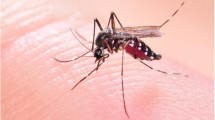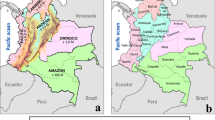Abstract
Climate, land use and land cover change influence infectious disease dynamics, particularly vector-borne diseases. Knowledge about mosquito ecology in southern Indiana is limited. Here, we present results from a season long study where we sampled mosquitoes at the Hickory Ridge Fire Tower in Hoosier National Forest, Monroe County, Indiana, USA. Using BG-Pro traps with BG-Lure and LED lights weekly from 23 May to 31 October 2023, we collected 178 mosquitoes over 24 weeks of sampling, encompassing a total of 120 trap-nights, with an average of 1.48 ± 3.41 (SD) mosquitoes per trap-night. The species accumulation curve for all the samples was flat, indicating a comprehensive sampling of species. We collected 10 species with a Chao2 ± SE species richness estimate of 14.46 ± 7.14. The dominant species was Aedes vexans (n = 58, 36%), followed by Culex spp. (composed of morphologically indistinguishable Culex pipiens and Culex restuans) (n = 51, 31%), Culex erraticus (n = 16, 10%), and Aedes triseriatus (n = 15, 9%). Because mosquitoes are ectothermic, they are highly sensitive to microclimatic variables such as temperature, humidity, and rainfall. Our time series analysis showed a significant association of mosquito abundance with the variability (SD and kurtosis) of the environmental variables we studied highlighting the importance of weather fluctuations in mosquito ecology. Our study highlights how weather variability shapes mosquito abundance, thus impacting disease vectors like Culex spp. and Aedes triseriatus with implications for arbovirus transmission in the context of climate change.




Similar content being viewed by others
Data Availability
All data is presented in the tables and figures included in this article.
References
Alencar J, de Mello CF, Serra-Freire NM, Guimarães A, Gil-Santana HR, Gleiser RM (2016) Biodiversity and temporal distribution of immature Culicidae in the Atlantic Forest, Rio de Janeiro state, brazil. PLoS ONE 11:e0159240. https://doi.org/10.1111/jvec.12189
Anderson JF, Main AJ, Ferrandino FJ (2020) Horizontal and vertical transmission of West Nile virus by Aedes vexans (Diptera: Culicidae). J Med Entomol 57:1614–1618. https://doi.org/10.1093/jme/tjaa049
CDC ArboNET Current Year Data (2023) Available from https://www.cdc.gov/westnile/statsmaps/current-season-data.html. Accessed 19 Feb 2024
Burkot TR, DeFoliart GR (1982) Bloodmeal sources of Aedes triseriatus and Aedes vexans in a Southern Wisconsin forest endemic for La Crosse Encephalitis virus. Am J Trop Med Hyg 31:376–381. https://doi.org/10.4269/ajtmh.1982.31.376
Chao A, Chazdon RL, Colwell RK et al (2006) Abundance-based similarity indices and their estimation when there are unseen species in samples. Biometrics 62:361–371. https://doi.org/10.1111/j.1541-0420.2005.00489.x
Chaves LF (2017) Climate change and the biology of insect vectors of human pathogens. In: Johnson SN, Jones TH (eds) Global Climate Change and Terrestrial Invertebrates. Wiley, Chichester, UK, pp 126–147. https://doi.org/10.1002/9781119070894.ch8
Chaves LF, Friberg MD (2021) Aedes albopictus and Aedes flavopictus (Diptera: Culicidae) pre-imaginal abundance patterns are associated with different environmental factors along an altitudinal gradient. Curr Res Insect Sci 1:100001. https://doi.org/10.1016/j.cris.2020.100001
Chaves LF, Hamer GL, Walker ED et al (2011) Climatic variability and landscape heterogeneity impact urban mosquito diversity and vector abundance and infection. Ecosphere 2:70. https://doi.org/10.1890/ES11-00088.1
Chaves LF, Hoshi T, Imanishi N (2015) Population dynamics of Armigeres subalbatus (Diptera: Culicidae) across a temperate altitudinal gradient. Bull Entomol Res 105:589–597. https://doi.org/10.1017/s0007485315000474
Chaves LF, Friberg MD, Moji K (2020) Synchrony of globally invasive Aedes spp. immature mosquitoes along an urban altitudinal gradient in their native range. Sci Total Environ 734C:139365. https://doi.org/10.1016/j.scitotenv.2020.139365
Clements AN (1992) The biology of mosquitoes. Volume 1: Development, nutrition and reproduction. Chapman & Hall, London, p 509. https://doi.org/10.1079/9780851993744.0000
Colwell RK, Coddington JA (1994) Estimating terrestrial biodiversity through extrapolation. Phil Trans Roy Soc London Ser B Biol Sci 345:101–118. https://doi.org/10.1098/rstb.1994.0091
Darsie RF, Ward RA (2005) Identification and geographical distribution of the mosquitoes of North America, north of Mexico. University Press of Florida Gainesville, FL
Day CA, Byrd BD, Trout Fryxell RT (2023) La Crosse virus neuroinvasive disease: The kids are not alright. J Med Entomol 60:1165–1182. https://doi.org/10.1093/jme/tjad090
Farajollahi A, Phelps J, Markley C et al (2005) Preliminary investigations with elevated evs traps in New Jersey. Wing Beats 16:35–37
Fitzgerald J, Livdahl T (2023) Vertical habitat stratification in Aedestriseriatus and Aedes hendersoni (Diptera: Culicidae): Complications associated with sloped and flood-prone landscapes. J Vector Ecol 48:113–123. https://doi.org/10.52707/1081-1710-48.2.113
Giordano BV, Cruz A, Pérez-Ramos DW et al (2021) Mosquito communities vary across landscape and vertical strata in Indian river county. Florida Pathogens 10:12. https://doi.org/10.3390/pathogens10121575
Gotelli NJ, Anderson MJ, Arita HT et al (2009) Patterns and causes of species richness: A general simulation model for macroecology. Ecol Lett 12:873–886. https://doi.org/10.1111/j.1461-0248.2009.01353.x
Hacker CS, Scott DW, Thompson JR (1973) Time series analysis of mosquito population data. J Med Entomol 10:533–543. https://doi.org/10.1093/jmedent/10.6.533
Harrington LC, Poulson LR (2008) Considerations for accurate identification of adult Culex restuans (Diptera : Culicidae) in field studies. J Med Entomol 45:1–8. https://doi.org/10.1093/jmedent/45.1.1
Hayes J, Hsi BP (1975) Interrelationships between selected meteorologic phenomena and immature stages of Culex pipiens quinquefasciatus Say: Study of an isolated population. J Med Entomol 12:299–308. https://doi.org/10.1093/jmedent/12.3.299
Hendy A, Hernandez-Acosta E, Valério D et al (2020) The vertical stratification of potential bridge vectors of mosquito-borne viruses in a central Amazonian forest bordering Manaus. Brazil Sci Rep 10:18254. https://doi.org/10.1038/s41598-020-75178-3
Hoshi T, Higa Y, Chaves LF (2014a) Uranotaenia novobscura ryukyuana (Diptera: Culicidae) population dynamics are denso-dependent and autonomous from weather fluctuations. Ann Entomol Soc Am 107:136–142. https://doi.org/10.1603/AN13071
Hoshi T, Imanishi N, Higa Y, Chaves LF (2014b) Mosquito biodiversity patterns around urban environments in South-Central Okinawa Island, Japan. J Am Mosq Control Assoc 30:260–267. https://doi.org/10.2987/14-6432R.1
Hoshi T, Imanishi N, MojiChaves K (2017) Density dependence in a seasonal time series of the bamboo mosquito, Tripteroides bambusa (Diptera: Culicidae). Can Entomol 149:338–344. https://doi.org/10.4039/tce.2016.64
Kitron UD, Webb DW, Novak RJ (1989) Oviposition behavior of Aedes triseriatus (Diptera: Culicidae): Prevalence, intensity, and aggregation of eggs in oviposition traps. J Med Entomol 26:462–467. https://doi.org/10.1093/jmedent/26.5.462
Leatherberry EC (2003) The forest resources of the Hoosier National Forest, 1998. Resour. Bull. NC-210. U.S. Department of Agriculture, Forest Service, North Central Research Station, St. Paul, p 54. https://doi.org/10.2737/NC-RB-210
Lewontin R, Levins R (2000) Schmalhausen’s Law. Capital Nat Social 11(4):103–108. https://doi.org/10.1080/10455750009358943
Mayer JD (2000) Geography, ecology and emerging infectious diseases. Soc Sci Med 50(8):937–952. https://doi.org/10.1016/s0277-9536(99)00346-9
Novak RJ, Peloquin J, Rohrer W (1981) Vertical distribution of adult mosquitoes (Diptera: Culicidae) in a northern deciduous forest in Indiana. J Med Entomol 18(2):116–122. https://doi.org/10.1093/jmedent/18.2.116
Pinto CS, Confalonieri UE, Mascarenhas BM (2009) Ecology of Haemagogus sp. and Sabethes sp. (Diptera: Culicidae) in relation to the microclimates of the Caxiuanã national forest, Pará Brazil. Mem Inst Oswaldo Cruz 104(4):592–598. https://doi.org/10.1590/s0074-02762009000400010
Poh KC, Chaves LF, Reyna-Nava M et al (2019) The influence of weather and weather variability on mosquito abundance and infection with West Nile virus in Harris County, Texas, USA. Sci Total Environ 675:260–272. https://doi.org/10.1016/j.scitotenv.2019.04.109
Reisen WK, Milby MM, Meyer RP (1992) Population dynamics of adult Culex mosquitoes (Diptera: Culicidae) along the Kern River, Kern County, California, in 1990. J Med Entomol 29:531–543. https://doi.org/10.1093/jmedent/29.3.531
Romero LM, Chaverri LG, Chaves LF (2019) Mosquito (Diptera: Culicidae) species composition in ovitraps from a Mesoamerican tropical montane cloud forest. J Med Entomol 56:491–500. https://doi.org/10.1093/jme/tjy170
Shumway RH, Stoffer DS, Stoffer DS (2006) Time series analysis and its applications, 2nd edn. Springer, New York, p 575
Silver JB (2007) Mosquito ecology: field sampling methods, 3rd edn. Springer Science & Business Media, New York, p 1494
Siverly RE (1972) Mosquitoes of Indiana. Indiana State Board of Health, Indianapolis, p 126
Williges E, Faraji A, Gaugler R (2014) Vertical oviposition preferences of the Asian tiger mosquito, Aedes albopictus, in temperate north america. J Am Mosq Control Assoc 30(3):169–174. https://doi.org/10.2987/14-6409R.1
Young CL, Chaon BC, Shan QA, Lobo NF, Collins FH (2008) A checklist of the mosquitoes of Indiana with notes on the cryptic species complexes Anopheles quadrimaculatus s.l. and Anopheles punctipennis. J Am Mosq Control Assoc 24(3):450–452. https://doi.org/10.2987/5669.1
Acknowledgements
We thank Aidan Simons for his valuable comments and edits to this manuscript. This work was funded by the Indiana University School of Public Health (IU-SPH). Sajjad Khan was also partially funded by a “Pay it forward” fellowship (IU-SPH).
Author information
Authors and Affiliations
Contributions
Conceptualization: [SK, MGA, LFC]; Methodology: [SK, MGA. CSB, AF, LFC]; Formal analysis and investigation: [SK, MGA, LFC], Writing—original draft preparation: [SK, CSB]; Writing—review and editing: [SK, MGA. CSB, AF, LFC], Funding acquisition: [LFC], Resources: [CSB, AF], Supervision: [AF, LFC].
Corresponding author
Ethics declarations
Competing interests
All authors declare that no competing interests exist.
Additional information
Publisher's Note
Springer Nature remains neutral with regard to jurisdictional claims in published maps and institutional affiliations.
Supplementary Information
Below is the link to the electronic supplementary material.
Rights and permissions
Springer Nature or its licensor (e.g. a society or other partner) holds exclusive rights to this article under a publishing agreement with the author(s) or other rightsholder(s); author self-archiving of the accepted manuscript version of this article is solely governed by the terms of such publishing agreement and applicable law.
About this article
Cite this article
Khan, S., Abel, M.G., Bibbs, C.S. et al. Mosquito (Diptera: Culicidae) species diversity and abundance patterns across tree height and microclimatic gradients in Indiana, USA. Biologia (2024). https://doi.org/10.1007/s11756-024-01698-2
Received:
Accepted:
Published:
DOI: https://doi.org/10.1007/s11756-024-01698-2




